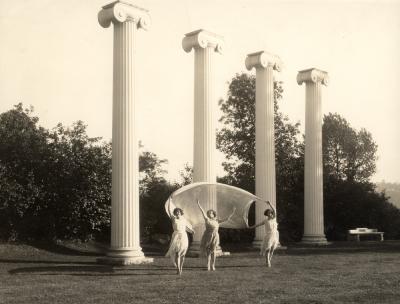October 7, 2004
‘Sacred space’ to be renewed
One of the University’s “sacred spaces” is getting a facelift. The Sylvan Theater, a secluded grove featuring a natural stage and the four columns from the original territorial university building downtown, will be closed for a year while its plantings are restored and its grounds get fitted with some modern conveniences.
“The intent is to bring this grove up to a more accessible ADA level and to improve the natural infiltration of sunlight,” said Ivan Turner, project manager in the Capital Projects Office. “Currently there’s a problem with not enough light in there and the plants are stunted.”
The Sylvan Theater — which is located on Stevens Way between Rainier Vista and the new Paul Allen Computer Science Center — is on the state register of historic places and is one of the spots listed as “unique and significant landscapes” in the University’s Master Plan. When Landscape Architecture Professor Iain Robertson conducted a survey in 1999, the Sylvan Theater was number four on a list of outdoor sites that the UW community wanted to protect at all costs (the top three were the Quad, the HUB yard and the Medicinal Herb Garden).
Those wishes will be respected in the current work, planners say. “We consider this to be a historical restoration project,” explained Susan Black, principal of SB & Associates and the landscape architect for the work. “What we’re doing is a combination of making the existing material that has a future life stronger so that it can keep growing and replacing weak plants with new ones.”
Because of the problem with lack of light, there will be “selective thinning of the trees,” Turner said. About 37 trees will be removed.
According to campus landscape architect Bill Talley, some of these trees are dead or declining and others are “volunteers” — not among the trees originally planted to be part of the grove.
The most notable trees to be removed are the Lawson cypress that are behind the columns on the Stevens Way side of the grove. These have been diseased and one has been lost, Black said, so they will be replaced by Siberian spruce, a tree that is not susceptible to the fungus that killed the cypress. Rhododendron will be a new addition on that side of the grove.
On the Rainier Vista side, the goal will be to restore the cedar trees that form the border. Those that are diseased will be replaced. The side nearest the computer center has felt the impact of construction and needs to be built up again. The other major goal relating to the plantings is to protect the four elm trees near the Drumheller Fountain entrance. To that end, a short pedestrian fence will be erected to discourage people from walking over the elm roots to get to the theater’s lawn.
The plantings aren’t the only part of the Sylvan Theater to be worked on. The ground will be graded and a path of porous asphalt will be installed around the perimeter, replacing the current dirt path. And the wooden steps that now lead up to the stage will be replaced by two sets of concrete steps (one on either side) with a handrail.
“These are very elegant, curved stairs that were carefully designed by Susan and her office and approved by the Campus Landscape Advisory Committee,” Talley said. “When people have graduation ceremonies at the theater, it will make it easier for participants to get onto the stage.”
An underground drainage system will be installed beneath the lawn. “This will serve two purposes,” Turner said. “It will keep the lawn from getting soggy and it’ll also allow a bit heavier use. It will be more like a baseball field.”
Heavy use of the space over the years combined with poor drainage has resulted in soil compaction, Talley said, which in turn means that chairs can sink into the soil too easily.
The final step in the renovation process will be the installation of an irrigation system.
While the grove itself is being worked on, the columns will be protected but will stay in place. Made out of cedar, they have already been reinforced with steel I beams anchored in concrete and their wooden caps have been replaced by fiberglass ones molded from the originals.
Few on campus are likely to know the history of the Sylvan Theater, which was designed to showcase the columns, saved by History Professor Edmund Meany when the original territorial university building was razed in 1908. They were first installed in the Quad between Savery and Raitt Halls, but in 1920, Architecture Professor Carl Gould decided to have a design competition among his students for the relocation and reuse of the columns. Sophomore Marshall W. Gill, son of Seattle Mayor Hiram Gill, won the First Mention prize for his design solution — incorporating the columns into a Sylvan Theater.
The theater was completed in 1921, but Gill died shortly thereafter, and his classmates raised money for a memorial to him. The memorial — a cast stone bench — sits near the columns in the Sylvan Theater.
That memorial, along with several others on the site, will be preserved and protected during the renovation work. If they need to be moved, they will be returned to their original spots.
The theater gets a lot of use. According to officials at the Outside Maintenance Zone, which is responsible for renting the site, it is the most used outdoor space on campus, with three or four events a month year round — events ranging from weddings to tailgate parties.
Because of its popularity, the Sylvan Theater will certainly be missed during its year off. The work — to be done by a private contractor — is scheduled to begin later this month.



